I gave a tour to a group of prospective brewers during the last weekend via the ECC Brewing Science program. There was a question about scaling beers up from a small scale (ours is 25 gallons) to a large scale (ours is 620 gallons – if we triple batch a beer, it could be up to 1,860 gallons).
Usually if a beer is dialed in at pilot scale, it will be about 90% of the way there for the first production batch, 95% for the second, and should be totally there by the third batch. But, I also shared with them one of the keys to making excellent beer at any scale: being able to objectively critique your own beer, deciding that you want to improve it, and then knowing what changes to make to achieve the desired result.
Continuous improvement is at work in everything we do here at Big Ditch. Even when things are going pretty well, we usually know that they could still be better. This applies not only to the beer we brew, but for just about everything else we do here as well. We are still a very young and new company, and we still have a lot to learn.
An example of this is our flagship IPA, Hayburner. As of this writing, we’ve revised the recipe or process for making Hayburner 83 times in the 3+ years we’ve been making it. Every single time we changed it was with the intention of making it better. The changes are usually pretty subtle, so hopefully you haven’t noticed that the beer is 83 times different than the first time you tried it! However, I suspect that if you put a glass of Hayburner from 2014 next to glass of Hayburner we just filled this week and drank them both, they would be somewhat similar, but pretty different also.
And, to be honest, not every change we make to a beer makes it better, at least in the short term. Sometimes the changes we make just don’t work out all that well. We have “broken” beers before with the goal of improving them. If that happens, we learn from it, reverse the changes, and move on.
So, when you taste a new beer from a brewery, or even when you taste any of the beers from a brand new brewery, you should cut them a little slack. If you don’t like something about the beer, let whoever served you the beer know what you liked and didn’t like about it, and make a mental note to come back to it after a few months. It will probably be better.
This brings us to the story of Deep Cut. For many of our brewers, our Deep Cut Double IPA is amongst the best beers that we make. Deep Cut has also won a few awards for us along the way, so undoubtedly, there are others who feel the same way. But for sure, it’s had its share of changes made as well. Since the first batch was brewed, we decreased the amount of specialty malt used, then added more adjunct grains, then decreased the bitterness, then added more late kettle hops, then found out this affected the appearance, then adjusted the water chemistry, then changed how the hops were added. In this latest batch, we’ve used more oats in the beer.
We think this is close to the best batch we’ve ever made of Deep Cut in terms of overall performance: appearance, bitter/sweet ratio, hop aroma and flavor, and mouthfeel (which is particularly creamy in this batch). And, if you haven’t tried it in a while, we think you should return to it and try it again. However, I think we’ve made 2 or 3 other batches of Deep Cut this year that were also the best batches of Deep Cut we’ve made.
This batch is even better than those, in our opinion.
That’s not to say we won’t still try to improve it the next time we brew it.
Thanks for sharing this journey with us. We hope you’re having as much fun as we are.

